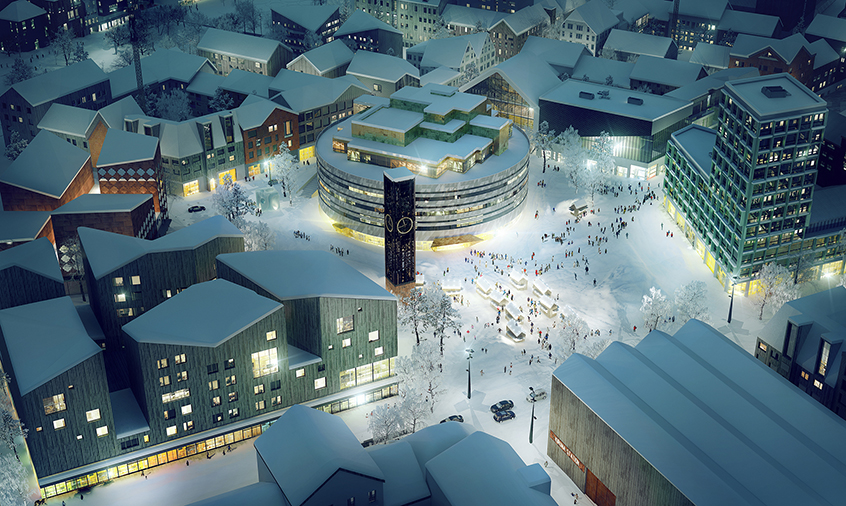Lots of places like to say they’re “a city on the move”, but for Sweden’s northernmost town, Kiruna, this is literally true.
It doesn’t have a choice.
Europe’s biggest iron producer, Sweden’s state-owned mining firm LKAB, founded Kiruna in 1900. It is now digging so close to the town of 23,000 people that it is in danger of sinking.
LKAB doesn’t want to stop mining, though. It believes there is ore in the ground to last until at least 2033, so it has put up $517m (€415.5m) to fund a seven-year relocation plan, at the end of which Kiruna will be 3km east of where it is now.
The bigger vision of the master planners – Stockholm-based White arkitekter, which won an international competition in 2013 – takes a hundred-year view.
It sees Kiruna becoming a model sustainable Arctic city no longer dependent on iron ore – and not so male-dominated.
LAKB actually flagged up the issue of subsidence due to its mining back in 2004, but it took nearly a decade to hatch a plan. The first phase of the move got under way in June.
‘With a thousand feet’
White says a series of projects will allow the city to “crawl” along a new urban belt to its new home.
Old Kiruna will gradually ‘phase out’ and the community will be drawn to the new, more vibrant town emerging to the east.
They will try and retain some of the character of old Kiruna by re-using materials from demolished buildings, while icons like the historic church will be taken down and put back up again in a new spot.
“Kiruna will be like a walking millipede, crawling, moving slowly with a thousand feet a few kilometres east,” said Mikael Stenqvist, White partner and lead architect on Kiruna.

How the new town centre could look when the move is complete (White arkitekter)
In the first phase, a new city hall, The Crystal, designed by Henning Larsen Architects, is scheduled to be finished in 2016. Kirunians will get a new swimming pool that year, too. Next will be a new civic square, home to Kiruna’s historic clock tower and a new travel centre, in 2018.
Tempting them east in 2019 will be a new library and by 2021 worshippers will have to go east to find the historic Kiruna Church, which by then will have been carefully deconstructed and moved.
Not so male-dominated
“The relocation presents an unparalleled opportunity for Kiruna to transform itself into a more environmentally, socially and economically sustainable city,” White says on its website.
New Kiruna will be carbon neutral, and not so male-dominated.
“A denser more intelligent plan, equipped with meeting places and cultural amenities, will promote public life, broadening the male-dominated demographic of Kiruna’s past, allowing a more diverse community to settle and thrive.”
Located 140km north of the Arctic Circle in Swedish Lapland, Kiruna is a challenging environment. The sun never sets in summer, or rises in winter. However, the plan includes harnessing vast amounts of waste heat generated by mining, building wind turbines and improved recycling.
White says its methodology puts people first. It has a team of in-house social anthropologists to engage with the community.
One outcome of that is the “Kiruna Portal”, an extra-large communal shop and “build it yourself” facility and construction recycling depot, where remnants of the old city can be reused, recycled and retrofitted into the new.
White says that the ratification of the masterplan and LKAB’s investment means that the citizens of Kiruna don’t have to put their lives on hold anymore.
Viktoria Walldin, White’s lead social anthropologist, said Kiruna would be “the most democratic urban transformation in the world”.
“The city plan is for a hundred years and the conversation with the residents of Kiruna needs to be for a hundred years as well,” she said.






